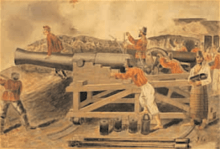George Thompson (engineer)

Teniente-Coronel George Thompson (1839-1876) was an English engineer, and was in charge of the Paraguayan military engineering in the Paraguayan War. He was the author of an important source on its history. Because of his efforts and the valour of the ordinary Paraguayans, the Allies (the Brazilian Empire, Argentina and Uruguay) found it much harder to defeat Paraguay than they had imagined.
Early life
Thompson was born at Greenwich on the 26th of March 1839. In 1849 he was sent to a school near Stuttgart, which he left in 1852, continuing his studies near London until 1854. From 1855 to 1857 he served an apprenticeship at the government works at Malta, and was put on the engineering staff of the gasworks in that island. He returned to England in 1857, and soon afterwards was engaged for one year as a draughtsman at a locomotive works. That was the sum total of his engineering experience when he left for South America in 1858, aged 19.[1]
Paraguay
In the middle of the nineteenth century the government of Carlos Antonio López determined to open up Paraguay to modern technology, hiring for that purpose a considerable number of technicians, mainly British.[2]
In September 1858 Thompson joined the staff of the Asunción and Villa Rica railway in Paraguay, working under the British engineers George Paddison, Burrell and Valpy. Although a young man, he was soon considered to be one of the best Guaraní scholars amongst the English, besides speaking fluently five or six other languages. [1]
The Paraguayan War

The war between Paraguay and the allied forces of Brazil and the Argentine and Uruguayan Republics having broken out, Thompson, in 1865, offered his services as a military engineer to the Paraguayan President, Francisco Solano López, and this offer being accepted, he joined the army in the June of that year, and took a prominent part in the war until the end of 1868. [1]
At the war’s outbreak Thompson was a railway engineer and he had no military experience at all. Furthermore throughout the war Paraguay’s nominal chief military engineer, the Hungarian colonel Wisner de Morgenstern (who had designed the Fortress of Humaitá) was seriously ill, and so the work fell on Thompson’s shoulders. Thus it was that an untried 26 year old man became the de facto chief military engineer of the Paraguayan army:[3]
I had no pretensions to a knowledge of military engineering or artillery beyond what I could pick up from some books which I was able to obtain in Paraguay, and which I studied for the occasion. The principal of these were Macaulay’s ‘’Field Fortification’’ and ‘’The Professional Papers of the Corps of Royal Engineers’’ and various works on artillery.

Improvising, he used the material and human resources of the country and made earthworks, fortifications and artillery emplacements. His most notable works were the fortifications of Angostura and the trenches – constructed, surreptitiously, overnight, in daring proximity to the Allies' positions – of the Boquerón del Sauce and Curupaity; Angostura held at bay the Allies’ fleet for several weeks, and the Curupaity trenches led to the Allies’ worst defeat of the war.[4][5][6]
Thompson was promoted to the rank of lieutenant- colonel in the Paraguayan army, and received from President Lopez the decoration of ‘’Caballero del órden del mérito’’ (Knight of the Order of Merit). Although obliged to capitulate at Angostura, the allies allowed him the honours of war, as he refused to surrender at discretion.[1]
.jpg)
After the war
A few months were passed in England in 1869, during which he wrote The War in Paraguay: With a Historical Sketch of the Country and Its People and Notes Upon the Military Engineering of the War. Since Thompson had been the foreigner with best access to President López – from whom he took his orders in Guaraní[8] – and privy to many military matters, the book is an important source on the history of the war. [9]
Thompson then returned to South America and married a Paraguayan woman by whom he had three children. After some topographical work in Córdoba, Argentina In 1870 he returned to Paraguay and became the Engineer and Manager of the Asunción – Villa Rica railway. He died in Asunción in March 1876, aged 37.[1]
Notes
References
- Institution of Civil Engineers Obituaries (1876). "George Thompson". Grace’s Guide. Retrieved May 2015. Check date values in:
|access-date=(help) - Plá, Josefina (1976). The British in Paraguay 1850-1870. The Richmond Publishing Co in association with St Antony’s College, Oxford.
- Thompson, George (1869). The War In Paraguay: With a Historical Sketch of the Country and Its People and Notes Upon the Military Engineering of the War. London: Longman’s, Green and Co. (Note: Not all bound copies of this important source book have a complete set of maps. A scanned version of a relatively good copy at the Boston Public Library was accessed at the Internet Archive on 29 April 2015. However, the Boston copy lacks pages 71-74 which describe the Battle of Riachuelo. These pages may be accessed from e.g. the Cornell University copy, also uploaded to the Internet Archive accessed 9 May 2016.)
- Washburn, Charles (1871). The History of Paraguay: With Notes of Personal Observations, and Reminiscences of Diplomacy Under Difficulties, vol. 2. Boston: Lee and Shephard.
- Whigham, Thomas L. (2002). The Paraguayan War, Volume 1, Causes and Conflict. Lincoln and London: University of Nebraska Press. ISBN 0-8032-4786-9.
- Batería paraguaya en Angostura dirigida por los comandantes Carrillo y Thompson: watercolour (21 x 30.3 cm), Museo Histórico de Buenos Aires “Brigadier General Cornelio de Saavedra”